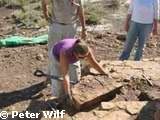Saturday, August 26, 2006
Insect predation sheds light on food web recovery after the dinosaur extinction
 The recovery of biodiversity after the end-Cretaceous mass extinction was much more chaotic than previously thought, according to paleontologists. New fossil evidence shows that at certain times and places, plant and insect diversity were severely out of balance, not linked as they are today. The extinction took place 65.5 million years ago. Labeled the K-T extinction, it marks the beginning of the Cenozoic Era and the Paleocene Epoch.
The recovery of biodiversity after the end-Cretaceous mass extinction was much more chaotic than previously thought, according to paleontologists. New fossil evidence shows that at certain times and places, plant and insect diversity were severely out of balance, not linked as they are today. The extinction took place 65.5 million years ago. Labeled the K-T extinction, it marks the beginning of the Cenozoic Era and the Paleocene Epoch.
'The K-T caused major extinction among North American plants and insects. The Western Interior U.S. was a dead zone for plants and plant-insect food webs,' said Dr. Peter Wilf, assistant professor of geosciences and the David and Lucile Packard Fellow. 'We know that right after the extinction, for 800,000 years, there was very low insect predation and plant diversity. We know that 9 million years afterwards, there was renewed diversity in both plants and insects. What happened in the 8 million years in between?
'In modern forests, insect diversity tracks plant populations. If there are few plants, there are few insects, and that is what we expected to see and mostly found throughout the 10-million-year Paleocene. However, we looked extremely hard to test this conventional wisdom and found some shocking exceptions that have given us new ideas about how food webs recover from mass extinction,' he added.
--
The above news release is based on the Science report "Decoupled Plant and Insect Diversity After the End-Cretaceous Extinction" (Abstract)
technorati tags: biodiversity, cretaceous, mass, extinction, recovery, fossil, evidence, plants, insects, diversity, k-t, cenozoic, paleocene, epoch, north+american, u.s., forests, modern, populations, food, webs
Add to: CiteUlike | Connotea | Del.icio.us | Digg | Furl | Newsvine | Reddit | Yahoo